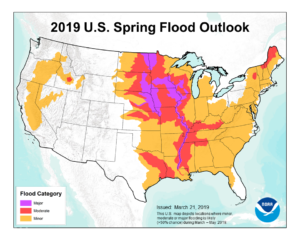
Historic, widespread flooding to continue through May
The spring flood outlook is not good news for those already devastated by flooding in the Midwest and down the Mississippi River, according to an outlook released by the US National Oceanic and Atmospheric Administration (NOAA).

Nearly two-thirds of the lower 48 states face an elevated risk for flooding through May, with the potential for major to moderate flooding in 25 states across the Great Plains, Midwest and down through the Mississippi River valley, according to the outlook. Additionally, the majority of the country is favored to experience above-average precipitation this spring, increasing the flood risk. The warning comes amid record flooding triggered by a sudden warm-up and heavy rains earlier this month brought on by the “bomb cyclone.”
Portions of the United States — especially in the upper Mississippi and Missouri River basins, including Nebraska, Minnesota and Iowa — have already experienced record flooding this year. This early flooding was caused by rapid snow melt combined with heavy spring rain and late season snowfall in areas where soil moisture is high. In some areas, ice jams are exacerbating the flooding. Additional spring rain and melting snow will prolong and expand flooding, especially in the central and southern U.S. As this excess water flows downstream through the river basins, the flood threat will become worse and geographically more widespread.
Flood Levels Defined
The National Weather Service, in coordination with local officials, defines flood levels for each of its river forecast locations when there is a greater than 50 percent or more likelihood of exceeding minor, moderate or major flood levels.
Minor Flooding: Minimal or no property damage, but possibly some public threat (e.g., inundation of roads).
Moderate Flooding: Some inundation of structures and roads near water sources. Some evacuations of people and/or transfer of property to higher elevations.
Major Flooding: Extensive inundation of structures and roads. Significant evacuations of people and/or transfer of property to higher elevations.
Record Flooding: Flooding which equals or exceeds the highest stage or discharge observed at a given site during the period of record.
Record winter precipitation across a large swath of the country has set the stage for the elevated flood risk. The upper Mississippi and Red River of the North basins have received rain and snow this spring up to 200 percent above normal. The areas of greatest risk for moderate to major flooding include the upper, middle and lower Mississippi River basins, including the main stem of the Mississippi River, Red River of the North, the Great Lakes, eastern Missouri River, lower Ohio, lower Cumberland and Tennessee River basins. Additionally, much of the U.S. east of the Mississippi River and portions of California and Nevada are at risk for minor flooding.
The flood risk outlook is based on a number of factors, including current conditions of snowpack, drought, soil moisture, frost depth, streamflow and precipitation. Local heavy rainfall, especially associated with thunderstorms, can occur throughout the spring and lead to flooding even in areas where overall risk is considered low. In the western U.S., snowpacks at higher elevations may continue to build over the next month, and the flood risk will depend on future precipitation and temperatures.
Click here to access NOAA images and video.
The International Code Council offers flood safety and recovery resources to help communities both prepare for floods and stay safe during the clean-up and restoration process. In addition, the Code Council and the National Council of Structural Engineers Associations, which have had a long-standing partnership in support of the design, construction and administration of safe and resilient buildings, have joined forces to create the Disaster Response Alliance (DRA). The goal of the DRA is to maintain a single, national database of skilled volunteers willing to assist jurisdictions with response as well as recovery activities, including building damage assessments, inspections and other code-related functions in the aftermath of a disaster.








